Working Game
Check out the working game -> https://tetris.trungk18.com
The game has sounds, wear your 🎧 or turn on your 🔊 for a better experience.
Please tweet and tag me @tuantrungvo for any issues that you are currently facing!
Thanks for your understanding. Stay tuned!
Source Code
 trungk18
/
angular-tetris
trungk18
/
angular-tetris
Tetris game built with Angular and Akita 🎮
If you like my work, feel free to:
- ⭐ this repository. And we will be happy together :)
- Tweet about Angular Tetris
Thanks a bunch for stopping by and supporting me!
Why?
Tetris was the first game that my dad bought for me and It cost about 1$ US at that time. It didn't sound a lot today. But 20 years ago, 1$ can feed my family for at least a few days. Put it that way, with 1\$ you can buy two dozens eggs.
This is the only gaming "machine" that I ever had until my first computer arrived. I have never had a SNES or PS1 at home.
My Tetris was exactly in the same yellow color and it was so big, running on 2 AA battery. It is how it looks.
After showing my wife the Tetris game built with Vue. She asked me why I didn't build the same Tetris with Angular? And here you go.
The game can hold up to a maximum score of 999999 (one million minus one 😂) and I have never reached that very end.
Who is this for?
I built this game dedicated to:
- For anyone that grew up with Tetris as a part of your memory. It was my childhood memory and I hope you enjoy the game as well.
- For the Angular developer community, I have never really seen a game that built with Angular and that's my answer. Using Akita as the underlying state management helps me to see all of the data flow, it is great for debugging. I wanted to see more Angular game from you guys 💪💪💪
How to play
Before playing
- You can use both keyboard and mouse to play. But prefer to use keyboard
- Press arrow left and right to change the speed of the game (1 - 6). The higher the number, the faster the piece will fall
- Press arrow up and down to change how many of lines have been filled before starting the game (1 - 10)
- Press
Spaceto start the game - Press
Pfor pause/resume game - Press
Rfor resetting the game - Press
Sfor the turn on/off the sounds
Playing game
- Press
Spacemake the piece drop quickly - Press
Arrow leftandrightfor moving left and right - Press
Arrow upto rotate the piece - Press
Arrow downto move a piece faster - When clearing lines, you will receive a point - 100 points for 1 line, 300 points for 2 lines, 700 points for 3 lines, 1500 points for 4 lines
- The drop speed of the pieces increases with the number of rows eliminated (one level up for every 20 lines cleared)
Techstack
I built it barely with Angular and Akita, no additional UI framework/library was required.
Development Challenge
I got the inspiration from the same but different Tetris game built with Vue. To not reinvented the wheel, I started to look at Vue code and thought it would be very identical to Angular. But later one, I realized a few catches:
- The Vue source code was written a few years ago with pure JS. I could find several problems that the compiler didn't tell you. Such as giving
parseInta number. It is still working though, but I don't like it. - There was extensive use of
setTimeoutandsetIntervalfor making animations. I rewrote all of the animation logic using RxJS. You will see the detail below. - The brain of the game also used
setTimeoutfor the game loop. It was not a problem, but I was having a hard time understanding the code on some essential elements: how to render the piece to the UI, how the calculation makes sense with XY axis. In the end, I changed all of the logic to a proper OOP way using TypeScript class, based on @chrum/ngx-tetris.
Tetris Core
It is the most important part of the game. As I am following the Vue source code, It is getting harder to understand what was the developer's intention. The Vue version inspired me but I think I have to write the core Tetris differently.
Take a look at the two blocks of code below which do the same rendering piece on the screen and you will understand what I am talking about. The left side was rewritten with Angular and TypeScript and the right side was the JS version.
I always think that your code must be written as you talk to people, without explaining a word. Otherwise, when someone comes in and reads your code and maintains it, they will be struggling.
“ Code is like humor. When you have to explain it, it’s bad.” – Cory House
And let me emphasize it again, I didn't write the brain of the game from scratch. I adapted the well-written source by @chrum/ngx-tetris for Tetris core. I did refactor some parts to support Akita and wrote some new functionality as well.
Akita state management + dev tool support
Although you don't dispatch any action, Akita will still do it undo the hood as the Update action. And you still can see the data with Redux DevTools. Remember to put that option into your AppModule
imports: [environment.production ? [] : AkitaNgDevtools.forRoot()];
I turn it on all the time on tetris.trungk18.com, you can open the DevTools and start seeing the data flow.
Note: opening the DevTools could reduce the performance of the game significantly. I recommended you turn it off when you want to archive a high score 🤓
Customizing Piece
I defined a base Piece class for a piece. And for each type of piece, it will extend from the same base class to inherit the same capability
export class Piece {
x: number;
y: number;
rotation = PieceRotation.Deg0;
type: PieceTypes;
shape: Shape;
next: Shape;
private _shapes: Shapes;
private _lastConfig: Partial<Piece>;
constructor(x: number, y: number) {
this.x = x;
this.y = y;
}
store(): Piece {
this._lastConfig = {
x: this.x,
y: this.y,
rotation: this.rotation,
shape: this.shape
};
return this._newPiece();
}
//code removed for brevity
}
For example, I have a piece L. I create a new class name PieceL. I will contain the shape of L in four different rotation so that I don't have to mess up with the math to do minus plus on the XY axis. And I think defining in that way makes the code self-express better. If you see 1, it means on the matrix it will be filled, 0 mean empty tile.
If my team member needs to maintain the code, I hope he will understand what I was trying to write immediately. Or maybe not 🤣
One import property of the Piece is the next property to display the piece shape on the decoration box for the upcoming piece.
const ShapesL: Shapes = [];
ShapesL[PieceRotation.Deg0] = [
[0, 0, 0, 0],
[1, 0, 0, 0],
[1, 0, 0, 0],
[1, 1, 0, 0]
];
ShapesL[PieceRotation.Deg90] = [
[0, 0, 0, 0],
[0, 0, 0, 0],
[1, 1, 1, 0],
[1, 0, 0, 0]
];
//code removed for brevity
];
export class PieceL extends Piece {
constructor(x: number, y: number) {
super(x, y);
this.type = PieceTypes.L;
this.next = [
[0, 0, 1, 0],
[1, 1, 1, 0]
];
this.setShapes(ShapesL);
}
}
Now is the interesting part, you create a custom piece by yourself. Simply create a new class that extends from Piece with different rotations.
For instance, I will define a new piece call F with class name PieceF. That is how it should look like.
const ShapesF: Shapes = [];
ShapesF[PieceRotation.Deg0] = [
[1, 0, 0, 0],
[1, 1, 0, 0],
[1, 0, 0, 0],
[1, 1, 0, 0]
];
export class PieceF extends Piece {
constructor(x, y) {
super(x, y);
this.type = PieceTypes.F;
this.next = [
[1, 0, 1, 0],
[1, 1, 1, 1]
];
this.setShapes(ShapesF);
}
}
And the last step, go to PieceFactory to add the new PieceF into the available pieces.
export class PieceFactory {
private _available: typeof Piece[] = [];
constructor() {
//code removed for brevity
this._available.push(PieceF);
}
}
And you're all set, this is the result. See how easy it is to understand the code and add a custom piece that you like.
The source code for that custom piece F, you can see at feature/pieceF branch.
Animation
I rewrote the animation with RxJS. See the comparison below for the simple dinosaurs running animation at the beginning of the game.
You could do a lot of stuff if you know RxJS well enough :) I think I need to strengthen my RxJS knowledge soon enough as well. Super powerful.
The actual result doesn't look very identical but it is good enough in my standard.
Web Audio API
There are many sound effects in the game such as when you press space, or left, right. In reality, all of the sounds were a reference to a single file assets/tetris-sound.mp3.
I don't have much experience working with audio before but the Web Audio API looks very promising. You could do more with it.
- See the official documentation
- See how I load the mp3 file and store it in sound-manager.service.ts
- Writing Web Audio API code that works in every browser
Keyboard handling
I planned to use @ngneat/hotkeys but I decided to use @HostListener instead. A simple implementation could look like:
@HostListener(`${KeyDown}.${TetrisKeyboard.Left}`)
keyDownLeft() {
this._soundManager.move();
this._keyboardService.setKeỵ({
left: true
});
if (this.hasCurrent) {
this._tetrisService.moveLeft();
} else {
this._tetrisService.decreaseLevel();
}
}
See more at containers/angular-tetris/angular-tetris.component.ts
Features and Roadmap
Phase 1 - Angular Tetris basic functionality
July 10 - 23, 2020
- Proven, scalable, and easy to understand project structure
- Basic Tetris functionality
- Six levels
- Local storage high score
- Sounds effects
- Limited mobile support
Phase 2 - Firebase high score, service worker, more sounds effect, more animation
TBD
- Fully mobile support
- Offline mode (play without internet connection)
- Firebase high score
- More sound effects
- More animations
Time spending
I was still working with Chau Tran on phase two of Angular Jira clone when I saw that Tetris game built with Vue. My wife wanted to have a version that I built so that I decided to finish the Angular Tetris first before completing Jira clone phase two.
According to waka time report, I have spent about 30 hours working on this project. Which is equal to run a marathon five times at my current speed 😩
The flow was easy. I designed a simple to do list, then start reading the code in Vue. And start working on the Angular at the same time. Halfway, I start to read @chrum/ngx-tetris instead of the Vue source. And keep building until I have the final result. 30 hours was a good number. It would take me longer, or lesser. But I enjoyed the experience working on the first-ever game I have built.
Setting up development environment 🛠
git clone https://github.com/trungk18/angular-tetris.gitcd angular-tetrisnpm start- The app should run on
http://localhost:4200/
Author: Trung Vo ✍️
- A young and passionate front-end engineer. Working with Angular and TypeScript. Like photography, running, cooking, and reading books.
- Author of Angular Jira clone -> jira.trungk18.com
- Personal blog: https://trungk18.com/
- Say hello: trungk18 [et] gmail [dot] com
Credits and references
| Resource | Description |
|---|---|
| @Binaryify/vue-tetris | Vue Tetris, I reused part of HTML, CSS and static assets from that project |
| @chrum/ngx-tetris | A comprehensive core Tetris written with Angular, I reused part of that for the brain of the game. |
| Game Development: Tetris in Angular | A detailed excellent article about how to build a complete Tetris game. I didn't check the code but I learned much more from that |
| Super Rotation System | A standard for how the piece behaves. I didn't follow everything but it is good to know as wells |
Contributing
If you have any ideas, just open an issue and tell me what you think.
If you'd like to contribute, please fork the repository and make changes as you'd like. Pull requests are warmly welcome.
License
Feel free to use my code on your project. It would be great if you put a reference to this repository.


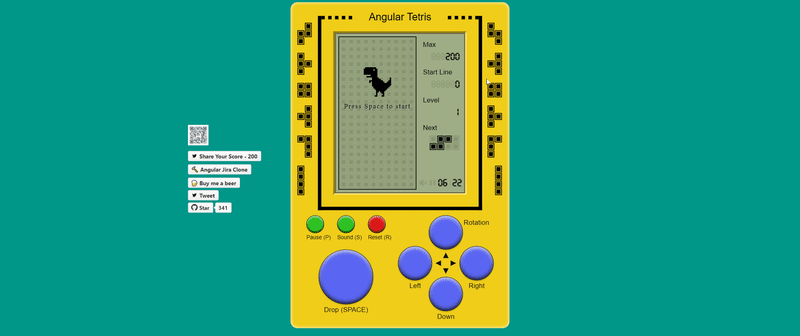
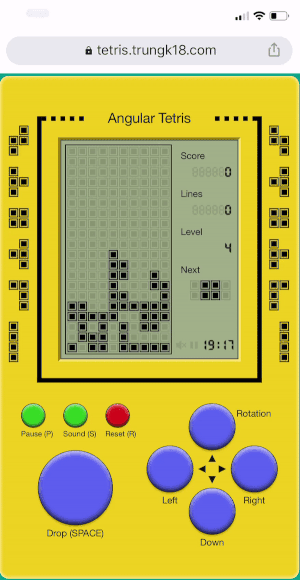
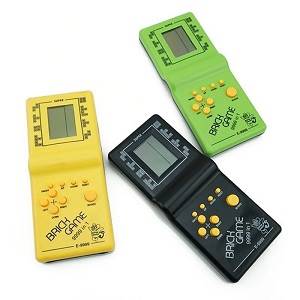


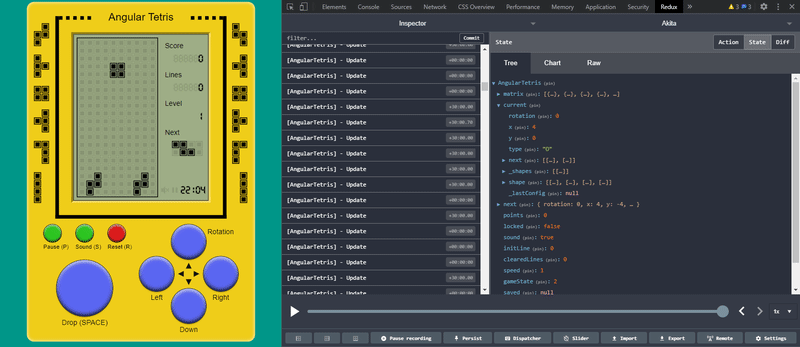
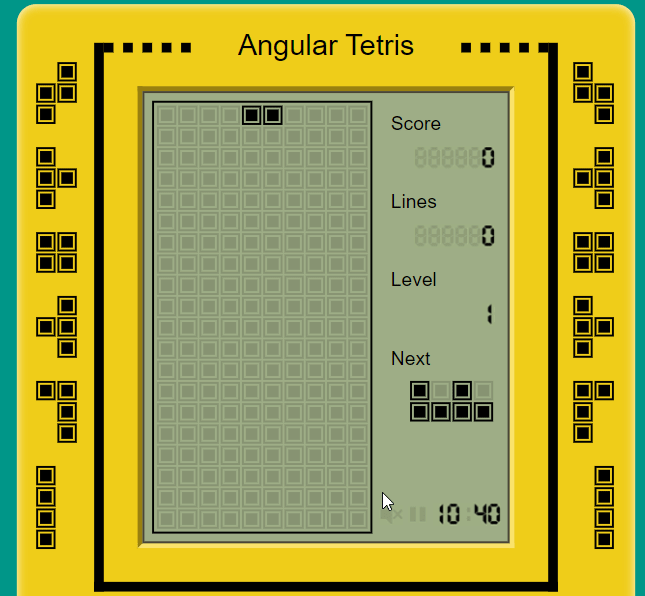
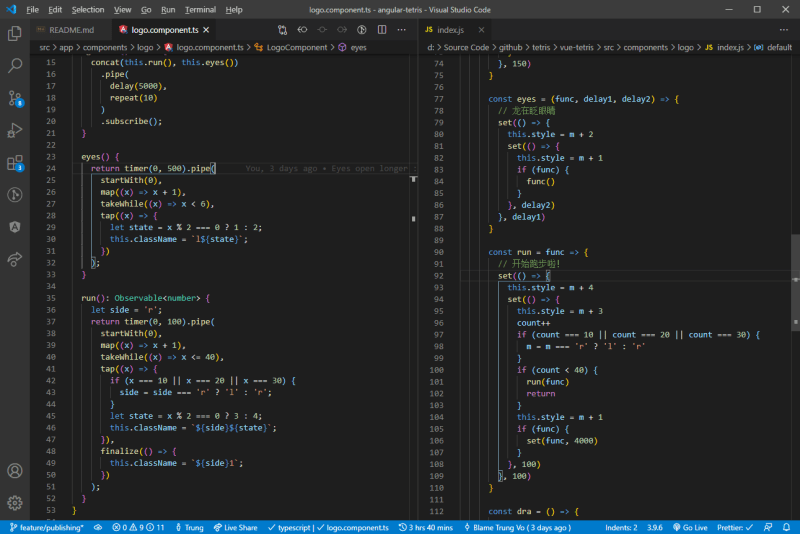

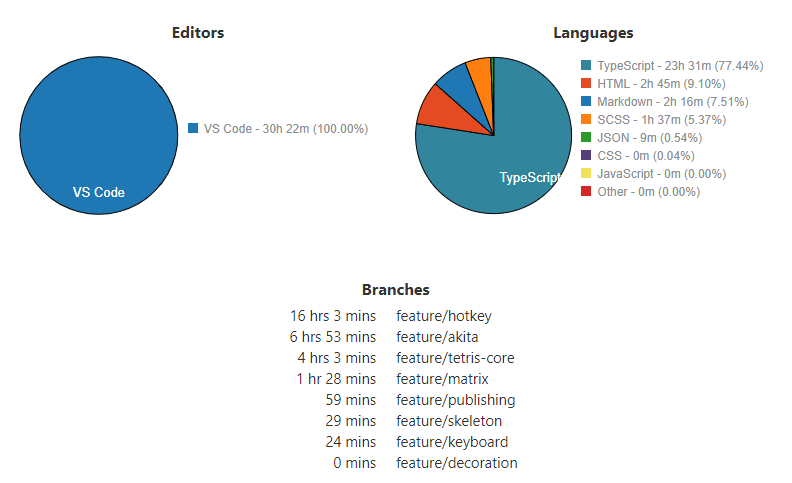





Top comments (8)
Hi. Look awesome.
Does it follow rules of Tetris?
For example, in Tetris next piece is pseudo random. Imagine all pieces in a bag and next piece is removed until bag is empty. tetris.fandom.com/wiki/Random_Gene... in the annimation example it looks like it does not follow it. As someone who played tons of Tetris this is something that I notice immediately. 😂
Hi Pavel, thanks for your feedback. I didn't really follow Tetris rule 100% 🤣 I hope you understand that
Well. You probably can look forward to a pull request then 😂😂
I am waiting for that 😂 🤣
github.com/trungk18/angular-tetris... here you go :D
Thank you! 😂
Hi, nice work,
Here is mine made with react and typescript with everything made from scratch : github.com/ecyrbe/triste
Nice, let me take a look 😁